
Located between Tokyo and Osaka, the Chubu region is full of sightseeing spots filled with beautiful nature and history. The combination of being close to the mountains and the Sea of Japan makes snowfall here utterly gorgeous. In the winter snowscape, you can feel the Japanese ambiance.
Here are seven recommended spots from popular snowy spots and events such as Japan's leading world heritage sites and castle ruins in the Chubu region.
- Table of Contents
-
- 1. Shirakawa-go: Feel like you are in the world of picture books
- 2. Kenrokuen Garden: Famous for its majestic snow landscapes
- 3. Kanazawa Castle: See the beautiful snowy scene of the castle town Kanazawa
- 4. Kanazawa Town: Beautiful snowy scenery in the tranquil old Geisha districts
- 5. Hida Takayama: Scenic traditional old townscapes filled with nature and history
- 6. Hida Folk Village/Hida no Sato and Shinhotaka Ropeway: A fantastic silver world spreads in front of you
- 7. Iiyama Snow Festival: Enjoy the fantastic illumination of the snowy country!
1. Shirakawa-go: Feel like you are in the world of picture books
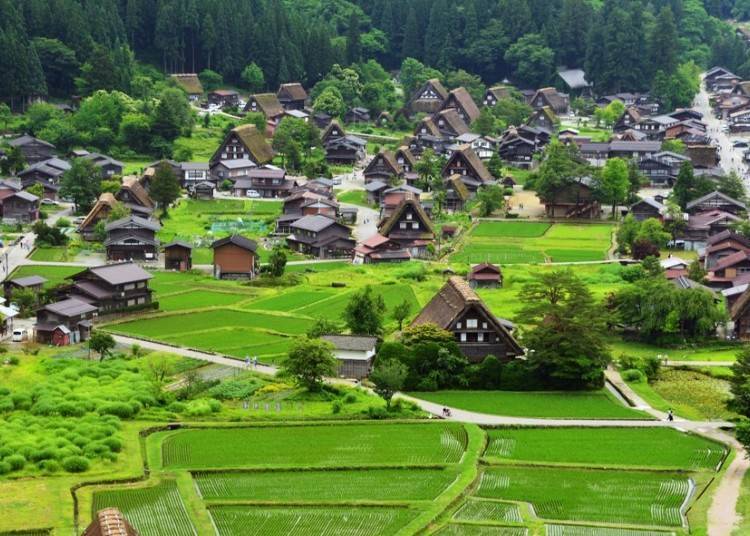
Shirakawa-go, a UNESCO World Heritage Site, is famous for its Gassho-style thatched roof houses. Gassho-zukuri is a unique Japanese architectural style that is constructed by placing wooden beams in a mountain shape. This structure is well suited to the natural conditions of Shirakawa-go, which sees a lot of heavy snow. There are still 300-year-old private houses in Shirakawa-go.
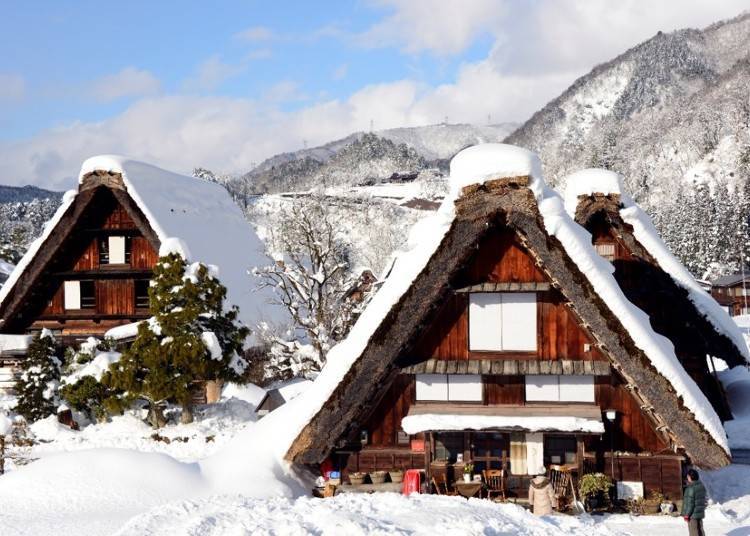
Shirakawa-go, one of Japan's leading heavy snowfall areas, is often covered with 2-3 meters of snow, and the scenery is a fantastic snow world. Particularly in January and February, it is worth seeing the townscape as it is illuminated at night – the white-capped roofs seem to float in the darkness of the night. You can enjoy the beautiful scenery of the whole village covered in snow.
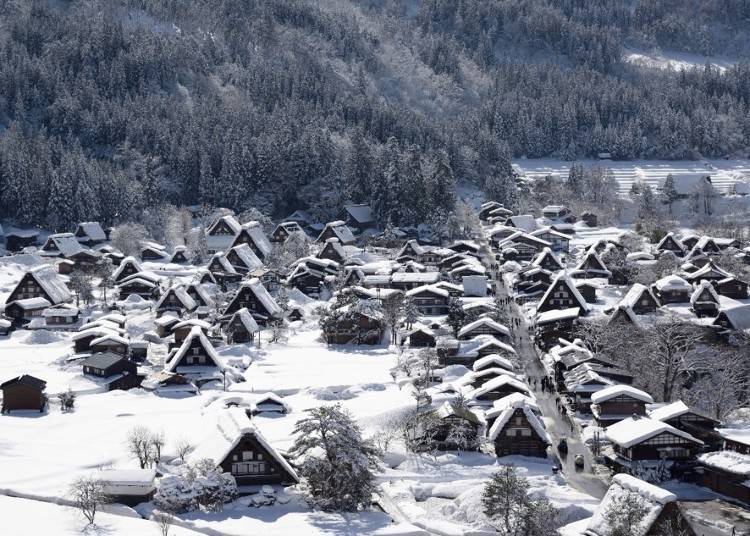
But when you visit, be sure to prepare! As it's quite cold, do wear a winter coat, boots, hat, and gloves that will shield you from the cold and wet snow.
-
Shirakawa-go白川郷
- Address Ogimachi, Ono Gun Shirakawa Mura, Gifu Ken, 501-5627, Japan
-
Nearest Station
Access: From Tokyo Station, take the JR Hokuriku Shinkansen to Kanazawa Station, or JR Hokuriku Main Line to Kanazawa Station (Nohi Bus/Hokuriku Railway Bus, 75 minutes)
From the Shinjuku Express Bus Terminal, take the Shinjuku-Hida Takayama Line express bus (Keio Bus/Nohi Bus, 5 hours 30 minutes), Takayama Nohi Bus Center-Shirakawago (Nohi Bus/Hokuriku Railway Bus/Toyama Chiho Railway Bus/Kaetsuno Bus/Iruka Bus, 50 minutes)
From Nagoya Station on the JR Tokaido Main Line (Gifu Bus, 165 minutes)
From Tokyo Station, take the JR Hokuriku Shinkansen to Toyama Station, or JR Hokuriku Main Line Toyama Station (Nohi Bus/Toyama Chiho Railway, Bus 70 minutes)
- Phone Number 05769-6-1013
2. Kenrokuen Garden: Famous for its majestic snow landscapes
Kenrokuen is one of Ishikawa Prefecture's most popular tourist spots. It is one of the three most famous Japanese gardens in Japan, along with Kairakuen in Ibaraki and Korakuen in Okayama and is renowned as a representative daimyo garden from the Edo period.
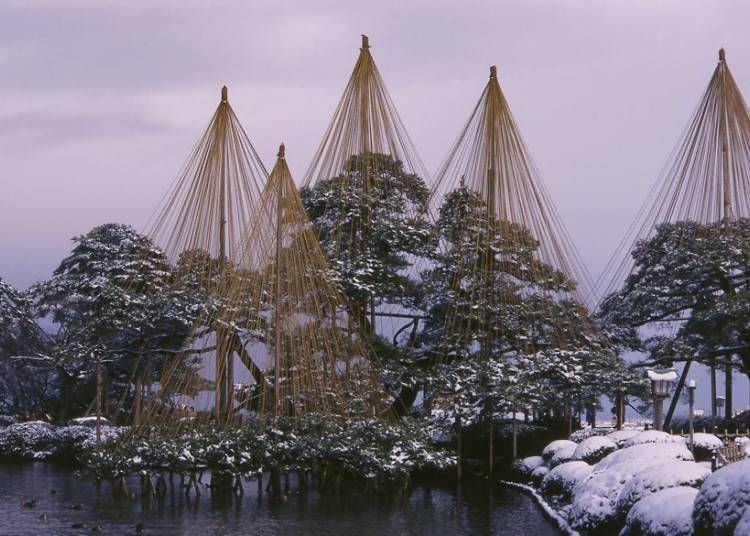
Yukitsuri (lit. "snow hanging") is a landscaping technique that takes place before the winter each year, whereby bamboo poles are erected, from which ropes are hung to support tree branches. This sight, which becomes rather trendy on social media each winter, is done so that the trees will not be broken due to the weight of the snow that accumulates. The scenery is stunning and has become a symbol of Kanazawa.
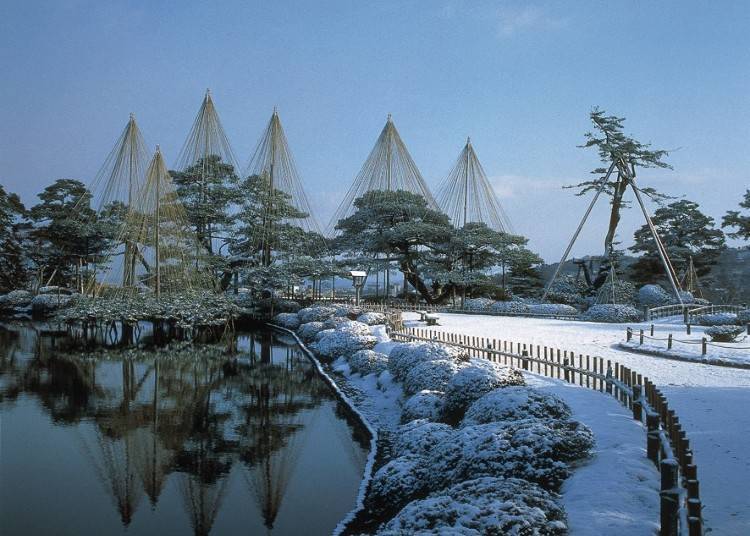
Yukitsuri work begins on November 1st every year and signals the start of winter. It takes about one month to complete (until around December). Five hundred gardeners will apply it to about 800 places according to the type of tree. Yukitsuri are usually removed around March 15th and takes about a week; this process tends to coincide with the start of spring.
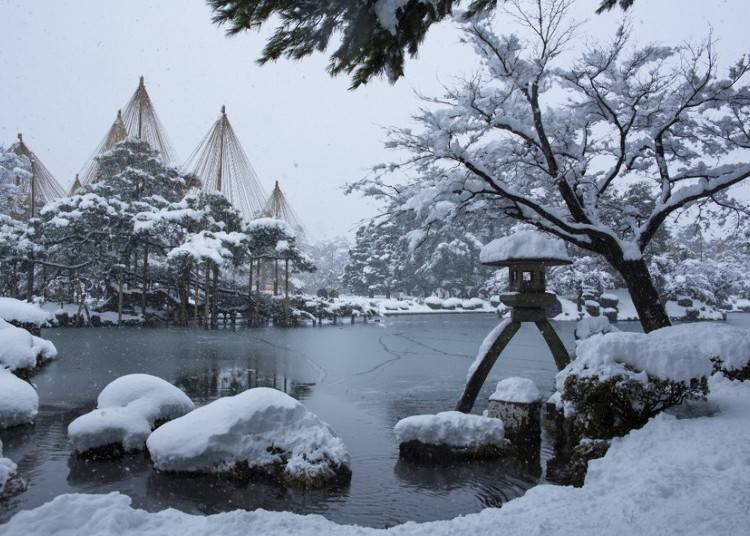
The snow-hung trees look like they are holding a Japanese umbrella. When the snow is piled up, it's elegant and beautiful.
-
Kenroku-en Garden兼六園
- Address 1 Kenrokucho, Kanazawa City, Ishikawa Prefecture
-
Nearest Station
Access: From Tokyo, take the Hokuriku Shinkansen to JR Kanazawa Station or Shinjuku Station Bus Terminal and take the night bus to Kanazawa Station West Exit
JR Kanazawa Station by Shirasagi limited express train from Nagoya, Kanazawa Station by highway bus from Nagoya
The Kenrokuen Shuttle bus runs daily from JR Kanazawa Station to the Kenrokuenguchi Bus Terminal.
From JR Kanazawa Station, get off at the bus Kenrokuen-shita/Kanazawa Castle-Kanazawa Castle Park (Ishikawa Gate), Kenrokuen (Katsura Sakaguchi/21st Century Museum of Contemporary Art), Hirosaka-Kanazawa Castle Park; Kenrokuen (Mayumi Sakaguchi Exit), get off at Dewacho-Kenrokuen (Kodatsuno Gate)
- Phone Number 076-234-3800
Admission: 18 years old and over, 320 yen; 6-17 years old, 100 yen
*Free admission for those over the age of 65 (proof required). Also, for those of other ages, there are times that the entrance fee is free, such as during the year-end and New Year holidays.
Closed: Open daily
3. Kanazawa Castle: See the beautiful snowy scene of the castle town Kanazawa
Kanazawa Castle, which is located right next to Kenrokuen Garden, is a faithful reproduction of the prized castle. Ishikawa-mon and Sanjuken-nagaya, structures that still exist from the Edo period, are designated as important cultural properties of the country.
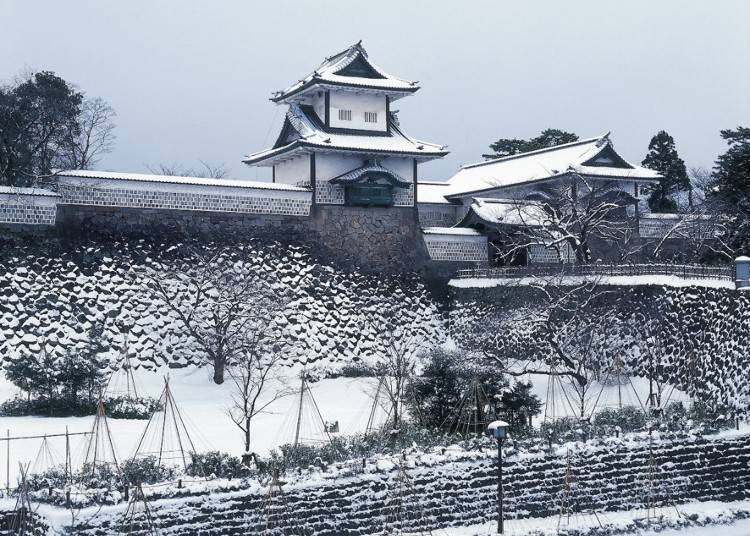
The snow-covered white roof and white walls of Kanazawa Castle are powerful and beautiful. The contrast with the stone walls is also fantastic, and it is a magnificent view in winter.
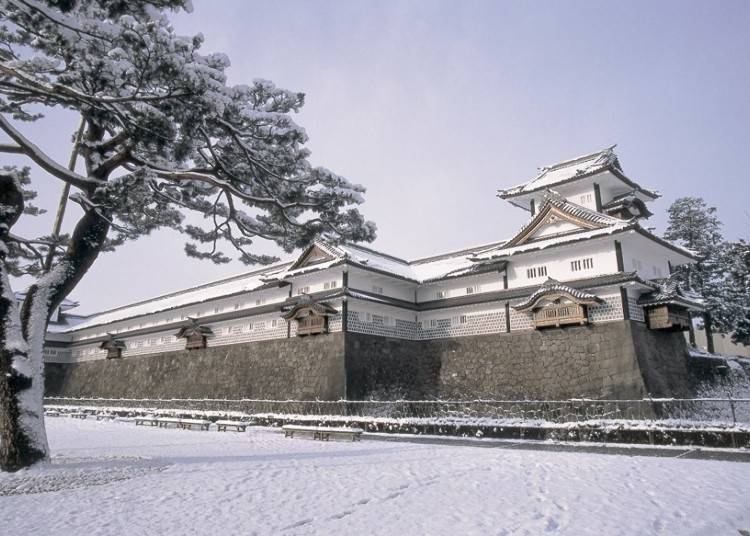
Kanazawa Castle Park centers around Kanazawa Castle and hosts a light-up event in winter. The trees and buildings in Kanazawa Castle and the adjacent Kenrokuen Garden are arranged in a fantastic display.
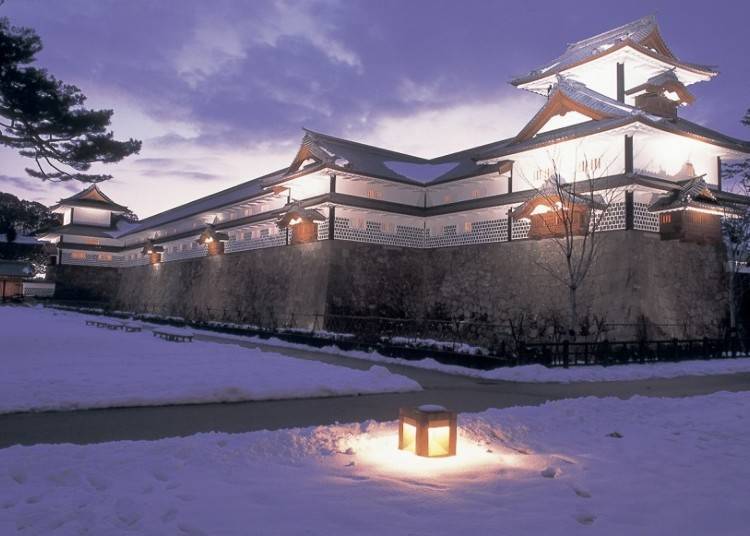
Kenrokuen and Kanazawa Castle reflect the history and culture of the region. Both have a fair number of slopes, so we recommend that you wear shoes that have good traction and are easy to walk in during the snow season.
-
Kanazawa Castle Park金沢城公園
- Address 1-1 Marunouchi, Kanazawa City, Ishikawa Prefecture
-
Nearest Station
Access: From Tokyo, take the Hokuriku Shinkansen to JR Kanazawa Station
Night bus from Shinjuku Station Bus Terminal to Kanazawa Station West Exit
JR Kanazawa Station by Shirasagi limited express train from Nagoya, Kanazawa Station by highway bus from Nagoya.
The Kenrokuen Shuttle bus runs daily from JR Kanazawa Station to the Kenrokuenguchi Bus Terminal.
From JR Kanazawa Station, get off at the bus Kenrokuen-shita/Kanazawa Castle-Kanazawa Castle Park (Ishikawa Gate), Kenrokuen (Katsura Sakaguchi/21st Century Museum of Contemporary Art), Hirosaka-Kanazawa Castle Park; Kenrokuen (Mayumi Sakaguchi Exit)
Facility name in English: Kanazawa Castle Park
- Phone Number 076-234-3800
Business hours: 7am to 6pm (March 1 to October 15)
8am to 5pm (October 16 to the end of February)
*Hishi-Yagura watchtower, Gojukken Nagaya, and Hashizume Ichi-no-mon Gate and Hashizume-mon Gate, 9am – 4:30pm (Last entry 4pm)
Price: Free admission
*Ryoto, Ikken Nagaya, Hashizumemon Sequel, Hashizumemon: 18 years old and over: 320 yen; 6-17 years old: 100 yen
Closed: Open daily
4. Kanazawa Town: Beautiful snowy scenery in the tranquil old Geisha districts
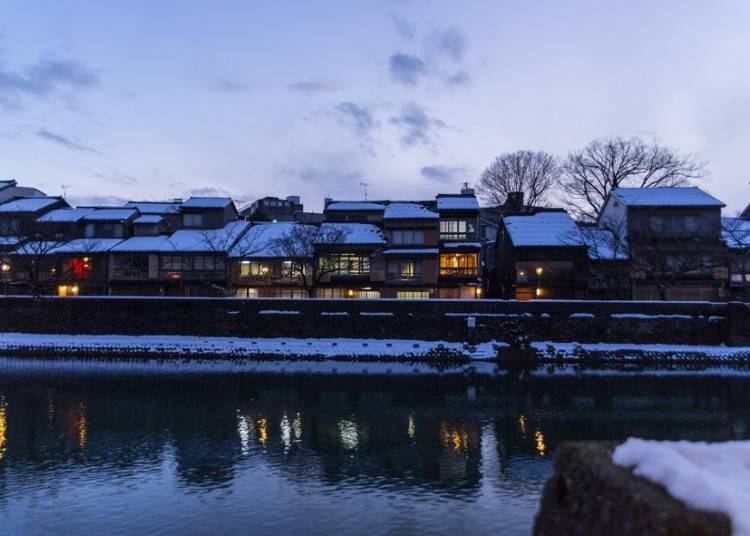
In Kanazawa's three geisha districts, you can really feel the history. There are three teahouse areas here that are well worth wandering through: Higashi Chaya District, Nishi Chaya District, and Kazuemachi Chaya District. In these teahouse districts, geisha in Kanazawa practice their art every day. You may also hear the sounds of drums and shamisen, especially in the evening. The scenery is simply spellbinding, and the snowy days make it even more attractive.

Kanazawa's geisha districts are lined with restaurants, machiya cafes, and souvenir shops selling traditional crafts. Be sure to rent a kimono and take a photo with a charming streetscape in the background.
-
Higashi Chaya Districtひがし茶屋街
- Address Higashiyama, Kanazawa City, Ishikawa Prefecture
-
Nearest Station
Access:
From Tokyo, take the Hokuriku Shinkansen to JR Kanazawa Station
Night bus from Shinjuku Station Bus Terminal Kanazawa Station West Exit
JR Kanazawa Station by Shirasagi limited express train from Nagoya, Kanazawa Station by highway bus from Nagoya
From Kanazawa Station
Kanazawa Loop Bus, Hokuriku Railway route bus, West Japan JR bus. It is about a five-minute walk from the Hashibacho bus stop
-
Nishi Chaya Districtにし茶屋街
- Address Nomachi, Kanazawa, Ishikawa Prefecture
-
Nearest Station
Access: From Tokyo, take the Hokuriku Shinkansen to JR Kanazawa Station
Night bus from Shinjuku Station Bus Terminal Kanazawa Station West Exit
JR Kanazawa Station by Shirasagi limited express train from Nagoya, Kanazawa Station by highway bus from Nagoya
From Kanazawa Station
Kanazawa Loop Bus, Hokuriku Railway route bus Hirokoji. From there, it is about a three-minute walk from the bus stop
-
Kazuemachi Chaya District主計町茶屋街
- Address >Kazuemachi, Kanazawa Shi, Ishikawa Ken, 920-0908, Japan
-
Nearest Station
Access:
From Tokyo, take the Hokuriku Shinkansen to JR Kanazawa Station
Night bus from Shinjuku Station Bus Terminal Kanazawa Station West Exit
JR Kanazawa Station by Shirasagi limited express train from Nagoya, Kanazawa Station by highway bus from Nagoya
From Kanazawa Station
Kanazawa Loop Bus, Hokuriku Railway route bus, West Japan JR bus. It is about a five-minute walk from Hashibacho bus stop

Kanazawa's Nagamachi Samurai District is lined with residences where samurai of the Edo period had lived. They are covered with komokake to protect the earthen walls from freezing snow in winter. Komokake are braided straw mats that prevent meltwater from getting into cracks in the soil, in turn preventing the soil from peeling off. It is a lot of work to apply them, but the resulting appearance is very popular with tourists as a winter tradition of Kanazawa.
-
Nagamachi Samurai District長町武家屋敷跡界隈
- Address Nagamachi, Kanazawa City, Ishikawa Prefecture
-
Nearest Station
Access:
From Tokyo
Take the Hokuriku Shinkansen to JR Kanazawa Station
Night bus from Shinjuku Station Bus Terminal Kanazawa Station West Exit
JR Kanazawa Station by Shirasagi limited express train from Nagoya, Kanazawa Station by highway bus from Nagoya
From Kanazawa Station
Kanazawa Loop Bus, Kenrokuen Shuttle, Hokuriku Railway route bus, West Japan JR bus: 5-minute walk from Korinbo bus stop
About 5 minutes from the Machi-Bus Korinbo Yamato Atrio Korinbo Tokyu Square, Bank of Japan bus stop
5. Hida Takayama: Scenic traditional old townscapes filled with nature and history
Takayama City, which retains the appearance of a castle town during the Edo period, is located in the northern part of Gifu Prefecture. Here, even the highest winter temperatures can still be well under freezing. You can enjoy the beautiful scenery with pure white snow on historic buildings and nature-rich landscape.
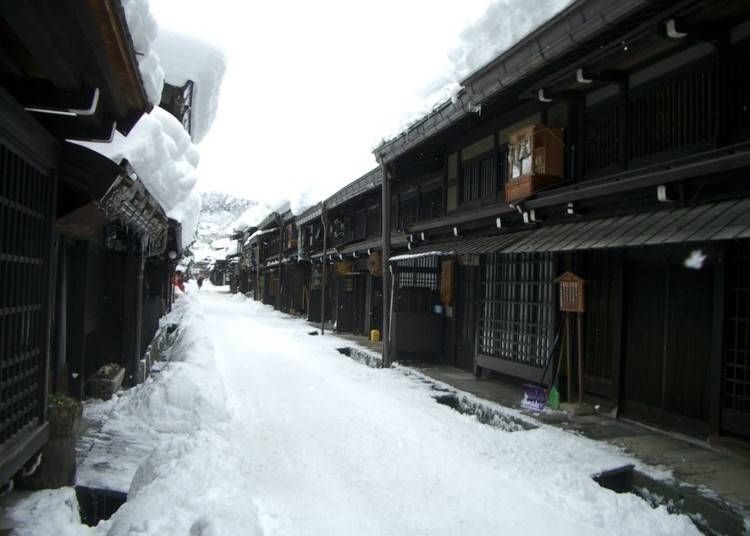
The old townscapes of Takayama City have been selected as one of the important preservation areas for traditional Japanese buildings and retains the image of the Edo period. The contrast between the Machiya architecture and the white snow that has accumulated adds to the atmosphere.

The Nakahashi Bridge over the Miyagawa River flowing through the center of Takayama City adds to the scenic air of the old town, making the snow appear as though it's wearing makeup. In winter, it is lit up, and the bridge stands out vividly, allowing you to enjoy the romantic scenery even more.
-
Sanmachi Traditional Buildings Preservation Area古い町並 三町伝統的建造物群保存地区
- Address Kami 1-nomachi, Takayama Shi, Gifu Ken, 506-0844, Japan
-
Nearest Station
Access: From Tokyo, take the JR Tokaido Shinkansen to Nagoya Station, or from Nagoya to JR Limited Express Hida Takayama Station
From Shinjuku Bus Terminal Express Bus Takayama Nohi Bus Terminal (Takayama Station)
A 12-minute walk from JR Takayama Station
- Phone Number 0577-32-3333
-
Nakabashi中橋
- Address Honmachi, Takayama Shi, Gifu Ken, 506-6023, Japan
-
Nearest Station
Access: From Tokyo, take the JR Tokaido Shinkansen to Nagoya Station, or from Nagoya to JR Limited Express Hida Takayama Station
From Shinjuku Bus Terminal Express Bus Takayama Nohi Bus Terminal (Takayama Station)
A 12-minute walk from JR Takayama Station
- Phone Number 0577-32-3333
6. Hida Folk Village/Hida no Sato and Shinhotaka Ropeway: A fantastic silver world spreads in front of you
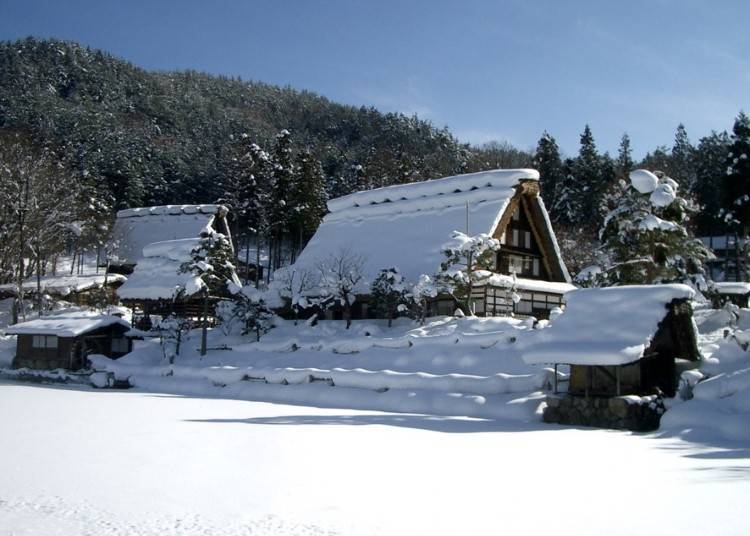
At the Hida Folk Village, an open-air museum filled with old farmhouses, in Takayama City, you can experience the old-fashioned lifestyle of Hida. Here, you can see traditional thatched roof homes with the peculiar gassho style, which is typical of the Hida district. It's incredible to see the 30 houses that are adorned with snow, appearing like something in a snowglobe.

Light up events are held in winter. While enjoying the snowy scenery of old rural villages, you can thoroughly experience Japanese tradition.
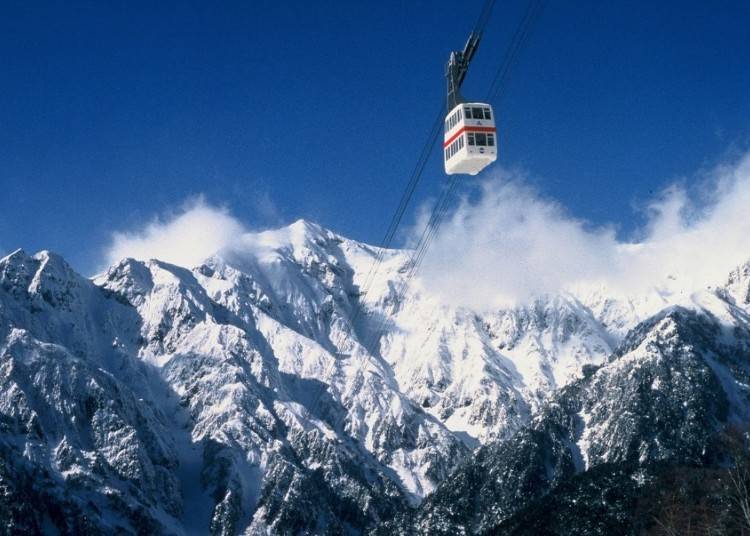
The Shinhotaka Ropeway, which has an altitude of 2156m, is located in the Shinhotaka area. It is Japan's only two-story gondola, and it has a 360-degree view of the northern Alps. Its power and beauty are overwhelming. You'll be amazed at the vast silver world and the mountains of the Northern Alps.
The gondola was renovated in July 2020, and the gondola's glass surface was expanded to provide a clearer view. Also, a multilingual information monitor was installed in the car.
-
Hida Folk Village飛騨民俗村・飛騨の里
- Address 1-590 Kamiokamotocho, Takayama City, Gifu Prefecture
-
Nearest Station
Access:
From Tokyo by JR Tokaido Shinkansen
From Shinjuku Bus Terminal Express Bus Takayama Nohi Bus Terminal (Takayama Station)
From Nagoya JR Express Hida Takayama Station
Immediately from JR Takayama Station, get off the Nohi Bus Takayama City Line Sarubobo Bus and Takumi Bus Hida no Sato
- Phone Number 0577-34-4711
Business hours: 8:30am to 5pm
Price: High school students and above: 700 yen; Elementary and junior high school students: 200 yen
Closed: Open daily
-
Shinhotaka Ropeway新穂高ロープウェイ
- Address >Okuhidaonsengo Kansaka, Takayama Shi, Gifu Ken, 506-1421, Japan
-
Nearest Station
Access:
From Tokyo, take the JR Tokaido Shinkansen to Nagoya Station, or from Nagoya to the JR Limited Express Hida Takayama Station.
Get off at JR Takayama Station and get off at the Nohi Bus bound for the Shinhotaka Ropeway for 1 hour and 40 minutes.
From the Shinjuku Bus Terminal, take the high-speed bus Shinjuku-Hida Takayama Line to the Hirayu Onsen bus stop. Take a local bus from Hirayu Onsen and get off at Shinhotaka Ropeway bus stop.
- Phone Number 0578-89-2252
Business hours:
April 1st to November 30th: 8:30am to 4pm
August 1st to 31st: 8am to 4pm
October Saturdays, Sundays, and holidays: 8am to 4pm
December 1 to March 31: 9am to 3:30 * Shinhotaka Onsen (up)
Price: 1st and 2nd ropeway connection: 1700 yen
1st ropeway: 400 yen
2nd ropeway: 1600 yen *Adult (13 years old and over)
Closed: Open daily
7. Iiyama Snow Festival: Enjoy the fantastic illumination of the snowy country!
The Iiyama Snow Festival, held in Iiyama City, Nagano Prefecture, is a winter event held every second Saturday and Sunday of February by Iiyama locals and people in the surrounding area.

Iiyama City is located on the prefectural border with Niigata Prefecture in the northern part of Nagano Prefecture. It is one of the densest snowfall areas in Japan. It is held with the concept of having fun playing with snow and experiencing the beauty of snow.

There are more than 100 snow statues in the town, each of which has been created by locals, including elementary school students at their own schools. Some of the streets around town are lined by smaller-scale snow sculptures and snow lanterns, making for very pretty and photogenic scenery. There is also a snow statue contest and a snow statue walk rally to check the snow statues. At night, it is illuminated and is very beautiful.

Your feet may get cold or wet, so we recommend boots or warm, waterproof shoes or boots.
-
Iiyama Snow Festivalいいやま雪まつり
- Address 1370-1 Iiyama, Iiyama City, Nagano Prefecture (Iiyama City Cultural Exchange Center Natura) *The address of the main venue in 2020.
-
Nearest Station
Access: From Tokyo, take the JR Hokuriku Shinkansen to JR Iiyama Station
From Nagoya, take the JR Chuo Main Line bound for Shinano Nagano to Nagano Station, and the JR Hokuriku Shinkansen to Iiyama Station
The town is a five-minute walk from JR Iiyama Station (Shuttle bus operates from the station square on the day)
- Phone Number 0269-62-0156
Date: Mid-February 2025
Price: Free admission
The Chubu region is easily accessible from Tokyo and Nagoya by highway bus and Hokuriku Shinkansen. Come and visit us to see the beautiful snow scenes that can only be found in winter in Japan.
Written by Yoko Okumura, Dali Corporation
*Prices and options mentioned are subject to change.
*Unless stated otherwise, all prices include tax.
Popular Tours & Activitiess
Recommended places for you
-
Appealing

Rukku and Uohei
Izakaya
Sapporo / Chitose
-

ISHIDAYA Hanare
Yakiniku
Kobe, Sannomiya, Kitano
-

Kambei Sannomiyahonten
Yakiniku
Kobe, Sannomiya, Kitano
-

Kanzenkoshitsuyakinikutabehodai Gyugyu Paradise Sannomiya
Yakiniku
Kobe, Sannomiya, Kitano
-

Jukuseiniku-to Namamottsuarera Nikubaru Italian Nikutaria Sannomiya
Izakaya
Kobe, Sannomiya, Kitano
-
Goods

Yoshida Gennojo-Roho Kyoto Buddhist Altars
Gift Shops
Nijo Castle, Kyoto Imperial Palace
-

Japan’s Shinkansen Is About to Change Travel in an Unexpected Way
by: Guest Contributor
-
Ad

Discover the "Miraculous Forest" in the Heart of Tokyo: The Institute for Nature Study (9 Minutes from JR Meguro Station)
-
Ad

Complete Guide to Ueno's National Museum of Nature and Science, the Perfect Place to Visit on Rainy Days or With Children
-

Strawberries, Style, and Tokyo’s Coolest Neighborhood: Winter Afternoon Tea in Kichijoji
by: Guest Contributor
-

First Japan Cherry Blossom 2026 Forecast Announced! Here's When & Where to See Sakura in Japan
-

This Winter, Godzilla Takes Over Haneda Airport
by: Guest Contributor
-

Nothing Beats a Japanese Izakaya! 3 Awesome Izakaya in Umeda
by: WESTPLAN
-

Japan Winter 2025: National Holidays, Seasonal Festivals & Must-See Spots
by: Chien-Huang
-

Hoshinoya Kyoto: This Incredible Japanese Hotel Welcomes You By Boat on a Sakura-Filled River
-

Expert-Recommended! 10 Sapporo Hotels with Exceptional Breakfasts
by: Nobuka Kawashima
-

5 Gorgeous Glamping Sites in Tohoku: Comfortably Enjoy the Outdoors With Family
-

(Video) Walking Tour along Narita Omotesando - Quaint Historical Village near Narita Airport!
by: Victor Gonzalez
- #best sushi japan
- #what to do in odaiba
- #what to bring to japan
- #new years in tokyo
- #best ramen japan
- #what to buy in ameyoko
- #japanese nail trends
- #things to do japan
- #onsen tattoo friendly tokyo
- #daiso
- #best coffee japan
- #best japanese soft drinks
- #best yakiniku japan
- #japanese fashion culture
- #japanese convenience store snacks












